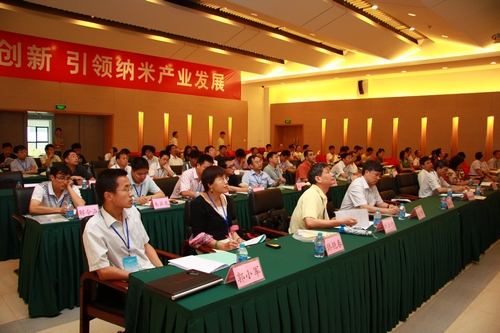
July 13, 2010, a one-day symposium on printed electronics was successfully held at the Suzhou Institute of Nanotech, Suzhou,Jiangsu Province. The symposium was jointly organized by the Suzhou Institute of Nanotech and the Institute of Chemistry, both of which are the research institutes of Chinese Academy of Sciences. As a parallel event, the “Printable Electronics Research Center (www.perc-sinano.com) ” of Suzhou Institute of Nanotech was officially unveiled at the symposium.
The symposium was the first of its kind held in China on the topic of printed electronics. More than 20 experts nationwide in the field of printed and organic electronics attended the event, including professors and researchers from Institute of Chemistry, Changchun Institute of Applied Chemistry, South China University of Technology, Beijing University, Shanghai Jiao Tong University, Jilin University, Shenyang Institute of Automation, Kunshan Hisense Electronics Co. Ltd. and Shanghai FoChif Mechatronics Technology Co. Ltd. Professor Zhenan Bao of Stanford University, USA, was invited to give a talk on subject of printed flexible electronics and E-skin. Seven Other talks were presented by experts from different organizations to introduce their work and to give overviews on printed electronics within and outside China. The Symposium was chaired by Professor Zheng Cui, Director of the newly established “Printable Electronics Research Center” at the Suzhou Institute of Nanotech. The Director of the Institute, Professor Hui Yang, and the deputy director, Mrs. Peihua Liu, were also at the symposium, as well as researchers and students from the Suzhou Institute of Nanotech.
After all the presentations, there was a discussion among the attendees on the issues China is presently facing in the development of printed electronics technology. It was pointed out that China is a giant in printing media industry. There are currently 180,000 or so companies in one way or another are related to printing industry. However, China has so far overlooked an industry which can utilize printing technology for manufacturing electronics and systems, and a potentially vast market which goes with the industry. The R&D resource and funding was scarcely allocated to the printed electronics area. The research activity in this area was next to none, which resulted in China was lagging far behind Europe, America and other countries in Asia in printed electronics technology.
It was agreed by the participating experts that printed electronics is not a simple transfer of paper printing to electronic device manufacturing. There are many problems and issues involving materials, equipments, processes and design of printed electronics. Many of them are boiled down to basic scientific issues that have to be investigated. There was a consensus among the attendees that China has to plan research programs now in printed electronics, or may lose the potentially big market of printed electronics products to foreign companies in future.
The symposium has well served its purpose of getting the research experts and groups in printed electronics in China together for the first time. They hoped the symposium to become a starting point from which the printed electronics research community grows and the industry flourishes. They all agreed that a lot of work needs to be done to promote the printed electronics, both the technology and applications, in China, and to lobby central government to put sufficient R&D resources into this area. “There is a bright future in printed electronics in China. We’ll have to work hard to get there”, which was the concluding remark made by the symposium chair.

